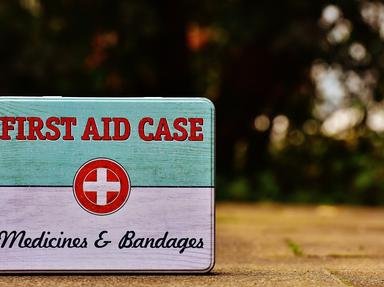Quiz Answer Key and Fun Facts
1. Your friend has been doing his impression of the "Karate Kid" painting his fence and now complains his wrist is sore. Which symptom is he most likely to be diagnosed with?
2. What does the acronym R.T.C. stand for?
3. You watch a co-worker go unconscious and fall to the floor from choking on a piece of food. What is the proper treatment for dislodging the object?
4. Your friend cuts his arm with a sharp knife. Direct pressure doesn't stop the bleeding. What else is required?
5. You have a suspected neck injury. What is the common name of the item you need to apply to the patient?
6. You are splinting a broken leg and are going to apply traction. The break is in the middle of the femur. What rule did you remember to know that traction was acceptable on this injury.
7. You find your patient has become pale and cool and is sweating slightly. You know that they are going into shock. What is the most important thing in the field regarding the treatment of shock?
8. You have a patient secured in the spine board and are transporting to hospital when they vomit. What do you need to do to help keep their airway clear?
9. A mechanic is cleaning his coveralls with his compressed air gun. He feels a sharp pain in his leg. When you look at it you see a small hole and a tiny amount of blood. Can you treat this injury by yourself?
10. You are treating an open chest wound. You do not seal it completely as it may cause this to occur.
Source: Author
trivnut25
This quiz was reviewed by FunTrivia editor
crisw before going online.
Any errors found in FunTrivia content are routinely corrected through our feedback system.
